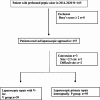A simple and effective technique for laparoscopic gastrorrhaphy: modified Graham's patch with barbed suture
- PMID: 37759211
- PMCID: PMC10537802
- DOI: 10.1186/s12893-023-02192-3
A simple and effective technique for laparoscopic gastrorrhaphy: modified Graham's patch with barbed suture
Abstract
Introduction: Peptic ulcers are caused by unbalanced acid production, and proton pump inhibitors (PPIs) in recent decades have helped to treat peptic ulcers effectively. Meanwhile, the incidence of perforated peptic ulcer (PPU) persists and has a high mortality rate if there is no adequate management. Primary closure with a modified Graham's patch was well performed in early detected PPU with a small size < 2 cm. A laparoscopic approach for PPU was prescribed for decades with proven feasibility and safety. We introduced an effective technique combined with barbed suture and modified Graham's patch, which can significantly reduce the surgical time without significantly increasing morbidity and mortality compared with traditional interrupted suture.
Patients and method: We retrospectively collected data from January 2014 to December 2020 in Keelung Change Gung Memorial Hospital, and a total of 154 patients receiving laparoscopic repair of PPU were included. There were 59 patients in the V-loc group (V group) and 95 patients in the laparoscopic primary repair group (P group).
Results: The V group had a significantly shorter operation time than the P group (96.93 ± 22.14 min vs. 123.97 ± 42.14, P < 0.001). Ten patients suffered from morbidity greater than the Clavien‒Dindo classification 4 (5 from V group, and 5 from P group). Three patients with leakage were reported. Two patients were in the V group, and one patient was in the P group (p = 0.432).
Conclusion: Laparoscopic repair with barbed suture and modified Graham's patch provides a simple and effective technique in the management of acute abdomen. This technique can be easily performed by experienced surgeons and trainees in minimally invasive surgery without affecting patient safety.
Keywords: Barbed suture; Laparoscopic; Modified Graham’s patch; Perforated peptic ulcer; Peritonitis.
© 2023. BioMed Central Ltd., part of Springer Nature.
Conflict of interest statement
The authors declare no competing interests.
The authors, including Ta-Chun Chou, Chun-Hui Lee, Ruey-Shyang Soong and Yi-Chan Chen, declare that the research was conducted in the absence of any commercial or financial relationships that could be construed as a potential conflict of interest.
Figures
References
-
- Moller MH, Adamsen S, Thomsen RW, Moller AM: Multicentre trial of a perioperative protocol to reduce mortality in patients with peptic ulcer perforation. The British journal of surgery 2011, 98(6):802–810. - PubMed
MeSH terms
LinkOut - more resources
Full Text Sources
Medical




